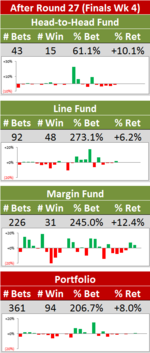Hanging Onto a Favourite: Assessing a Favourite's In-Running Chances of Victory
 Tuesday, July 19, 2011 at 8:30PM
Tuesday, July 19, 2011 at 8:30PM Over the weekend I was paying particular attention to the in-running odds being offered on various games and was once again felt that punters overestimated the probability of the favourite ultimately winning, especially when it was trailing.
I've investigated this issue before, in a slightly tangential manner, in this blog where I concluded that the starting prices of teams became virtually irrelevant to a proper assessment of their victory chances largely after half-time and almost entirely after three-quarter time.
In this blog I'll address the phenomenon more directly by fitting three binary logits, one for each quarter, to the scores from actual games over the period 2006 to 2010, where each logit will be of the form:
logit(Prob(Favourite Wins)) = Constant + a x Favourite's Implicit Probability at Start of Game + b x Favourite's Lead at the End of Quarter Q
where the Favourite's Implicit probability is estimated using the TAB Sportsbet pre-game head-to-head prices, Q takes on the values 1 to 3 in turn for each of the three models, and logit(x) = ln(x/(1-x))
(On a technical note I should point out that I excluded draws in fitting this model and I treated the Home team as the favourite in those games where both teams had the same pre-game price - that is, were equal-favourites.)
The three models are summarised in the following table:
The first column, for example, describes the model using the favourite's lead at the quarter-time break along with the favourite's pre-game probability, and is:
Prob(Favourite Wins) = logit(-2.67 + 4.98 x Favourite's Initial Implicit Probability + 0.06 x Favourite's Lead at Quarter Time)
The 71% underneath the coefficients for this so-called QT Model denotes that the fitted model correctly predicts the winning team in 71% of cases if we use 50% as the cutoff for converting the fitted probability it gives for the favourite's winning into a binary prediction of the outcome.
If you run your eye across the first three columns you'll see that, numerically, the coefficient multiplying the favourite's initial probability declines as the quarters proceed, hinting at the diminishing importance of this variable in predicting the ultimate game victor as asserted earlier.
To more formally measure the diminshment of the importance of the favourite's pre-game probability I employed the R hier.part package to estimate the individual contribution of the two regressors - the favourite's pre-game price and its lead at the quarter break - to the explanation of the model outcome, in this case the winning of the game. These estimates appear as the last three columns above and confirm that the favourite's pre-game probability independently contributes only 30% towards explaining a game's outcome even as early as the end of the first quarter. By half time its importance has shrunk to just 11%, and by three-quarter time to a mere 6%. In essence, virtually everything you need to know about the relative merits of the competing teams is encapsulated in the score by the time the final term rolls around.
Now that we've fitted these models we can ask some other interesting questions. For example, by how much can the favourite trail at a particular point in a game and still be legitimately considered as the team more likely to win?
In many cases, even for reasonably strong pre-game favourites, the answer is: not much. A team that was a 75% favourite - which means it was priced at about $1.25 pre-game - switches to being the underdog if it trails by 20 points at quarter time, 12 points at half time, or just 8 points at three-quarter time.
(The first line of this table might seem a bit odd at first glance. What it tells us is that a home team that is a pre-game equal favourite actually needs to be leading at quarter time by at least 4 points in order to assume the position of favourite to win the game. At the half, just a 1 point lead is enough to secure this outcome, and at three-quarter time it can actually afford to trail by 1 point, but no more, and still be favoured to win; presumably, the home crowd will be enough to tip the scales in their favour.)
The numbers for the 3QT model are particularly intriguing to me. Even a team that was a 90% favourite to win based on the pre-game odds - think $1.04 - will be the underdog in the contest if it trails by 11 points or more at the last change.
Now if we're thinking of having a flutter in-running we need to know more than just whether or not the pre-game favourite is still the favourite, we need to know what a fair price is for the pre-game favourite depending on the current score. The three binary logits can help us here again by allowing us to produce this table:

So, for example, consider the first table, which provides the relevant probabilities for the score at the quarter time break. If a team that was a 75% pre-game favourite is level with its opponent at quarter time, it's still an 86% chance of winning. If, instead, it trails by 4 goals, its chances are just one half of that, or 43%.
One interesting aspect of these tables is that they show that any pre-game favourite, regardless of the magnitude of its favouritism, has diminished chances of victory if it fails to lead at any change.
 TonyC |
TonyC |  Post a Comment |
Post a Comment | 



Reader Comments